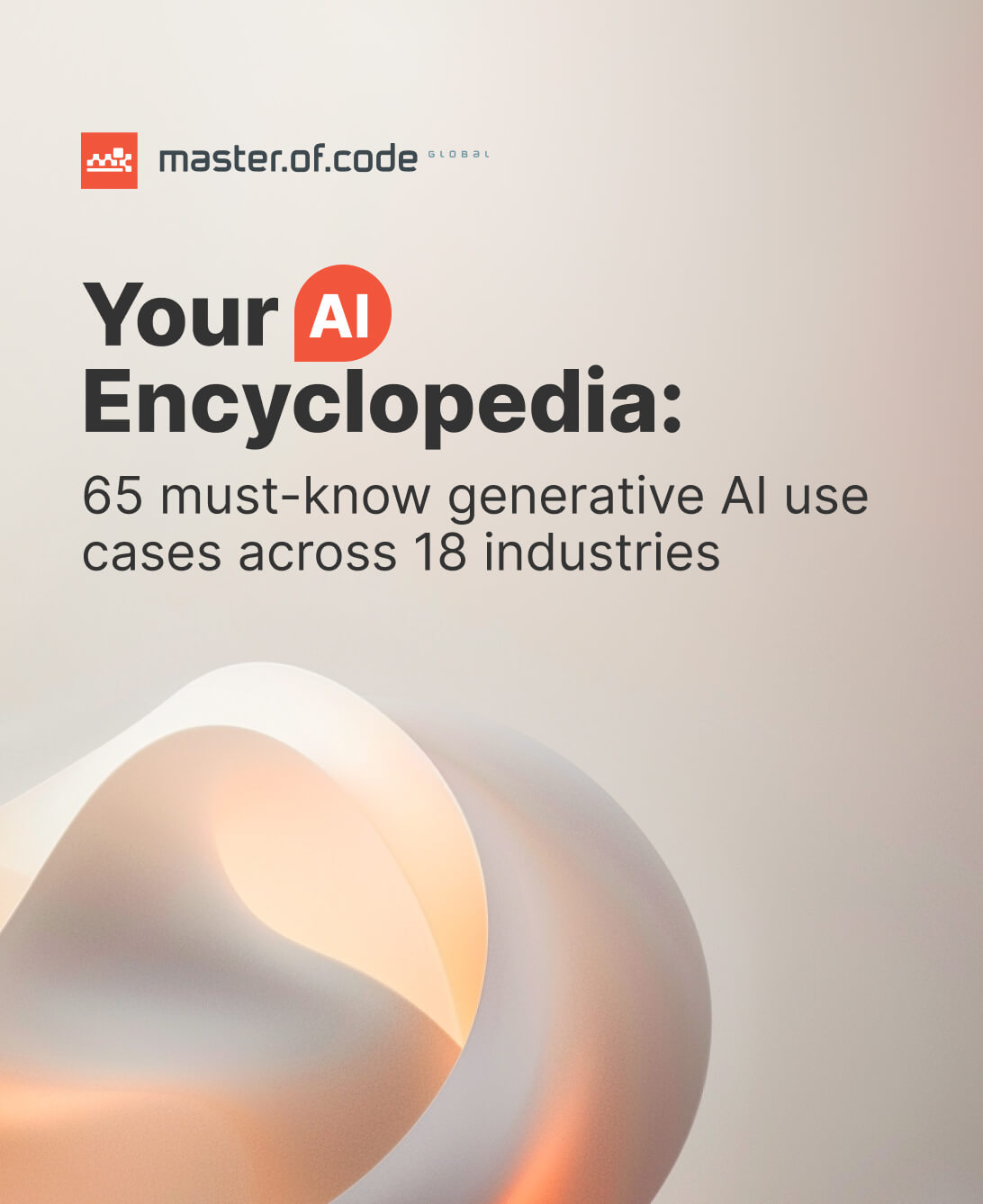Are you leaving money on the table by neglecting your interaction strategy? In today’s hyper-competitive landscape, businesses can’t afford to treat client retention as an afterthought. The consequences of poor involvement are staggering: companies lose an estimated $1.6 trillion per year due to user churn. Think about it – that’s $1.6 trillion vanishing into thin air, simply because companies aren’t effectively leveraging tools like chatbots for customer engagement to keep their consumers happy.
The reality is, today’s customers are accustomed to instant gratification. They expect immediate responses, personalized attention, and seamless experiences across all channels. Failing to meet these expectations can quickly lead to frustration, driving people straight into the arms of your competitors. But what if you could transform your service from a cost center into a profit driver?
A recent study found that 68% of users have already tried a client support bot. By proactively engaging people, offering help, and providing 24/7 availability, the chatbots can help you build stronger relationships with diverse audiences, boost loyalty, and ultimately, stop churn in its tracks. What’s the superpower of AI assistants? Let’s witness their capabilities in action. Continue reading to discover 6 major business cases resolved by timely incorporation of chatbots.

Table of Contents
So What Are Chatbots?
Chatbots are computer programs that impersonate human conversation in its natural format. They communicate using sophisticated artificial intelligence techniques, such as Natural Language Processing, through text or voice interfaces. Over time, a chatbot learns from previous interactions and becomes incrementally more intelligent, understanding nuances in text or speech and handling more complexity throughout the conversation. For 48% of users, it’s more important that a bot solves their issues effectively rather than has a personality.
- Bots are pivotal in transforming client journeys by offering instant assistance, resolving queries promptly, and reducing wait times. The capability to understand natural language allows them to comprehend client inquiries, delivering personalized responses and recommendations. By automating repetitive tasks, chatbots improve customer experience, streamline processes, and free human agents for more complex issues.
- Moreover, bots facilitate seamless navigation through product catalogs, guiding consumers to find what they need effortlessly. They provide consistent service, maintaining brand voice and standards across interactions, which fosters trust and loyalty. Additionally, chatbots gather valuable data, enabling businesses to analyze trends and preferences, thereby tailoring services accordingly.
- Furthermore, conversational bots offer round-the-clock availability, ensuring assistance is accessible whenever clients need it, regardless of time zones or holidays. This constant support contributes to a positive client journey, enhancing enhancing brand reputation and differentiation in a competitive market.
It’s not surprising that big enterprises are looking to reap the benefits of these intelligent machines and with increased interest follows improved performance. Want to be among the companies that get powerful insights and drive success with AI?
If the alternative was to wait 15 minutes for an answer, 62% of consumers would rather talk to a chatbot than a human agent. Enterprises understand the benefits and advantages that AI can bring not only to their bottom line but more importantly to their customers.
Beyond the Buzzwords: How Chatbots Deliver Tangible ROI
While the concept of digital tools may seem trendy, their impact on customer engagement and retention is far from superficial. Leading companies are increasingly recognizing the power of AI-driven conversational interfaces to transform their service operations. In fact, 36% of marketing executives report utilizing assistants to communicate with clients in their organizations. But how exactly do these virtual assistants translate into clear business results? Let’s dive into the most successful real-world examples.
Problem 1: Overwhelmed support teams leading to long wait times and frustrated customers.
Emma contacts her favorite tech brand’s client service but faces extended delays. The helpdesk is flooded with tickets, pushing response times to several days and leaving users increasingly irritated with the lack of timely assistance. The thing is that Sam, the support manager, believes extra resources aren’t necessary, overlooking the impact on consumer satisfaction and loyalty as response times continue to lag.
This is where an autonomous customer engagement chatbot comes into play, offering immediate help and personalized answers to enhance the overall experience.
Solution. To combat overwhelming requests and long wait times, Master of Code developed a bot for a leading biotechnology company. It empowers in-house teams to instantly escalate complex queries to supervisors for immediate assistance, ensuring faster resolution times and increased satisfaction. By seamlessly integrating with their existing SAP C4C CRM system and mirroring the flow of their previous platform, we ensured a smooth and intuitive transition for their support agents.

Problem 2: 24/7 availability for global brands.
Picture a user in London browsing exquisite jewelry online at 2 AM, needing assistance with sizing or shipping. Without instant backing, that potential sale might be lost. International businesses usually face the challenge of providing consistent help across different time zones. Customers expect assistance regardless of their whereabouts, making chatbots for enterprises a crucial tool for maintaining high-quality service and engagement around the clock.
Solution. Master of Code stepped in to craft a sophisticated routing jewelry retail bot for a luxury global brand. The solution is capable of intelligently directing inquiries to available agents, no matter the time or location.
During just the first month after the launch, this assistant has facilitated over 200 engaging conversations with Canadian clients, managed an impressive 4,603 supportive interactions with USA buyers, and enabled over 150 helpful chats with clients from the UK.
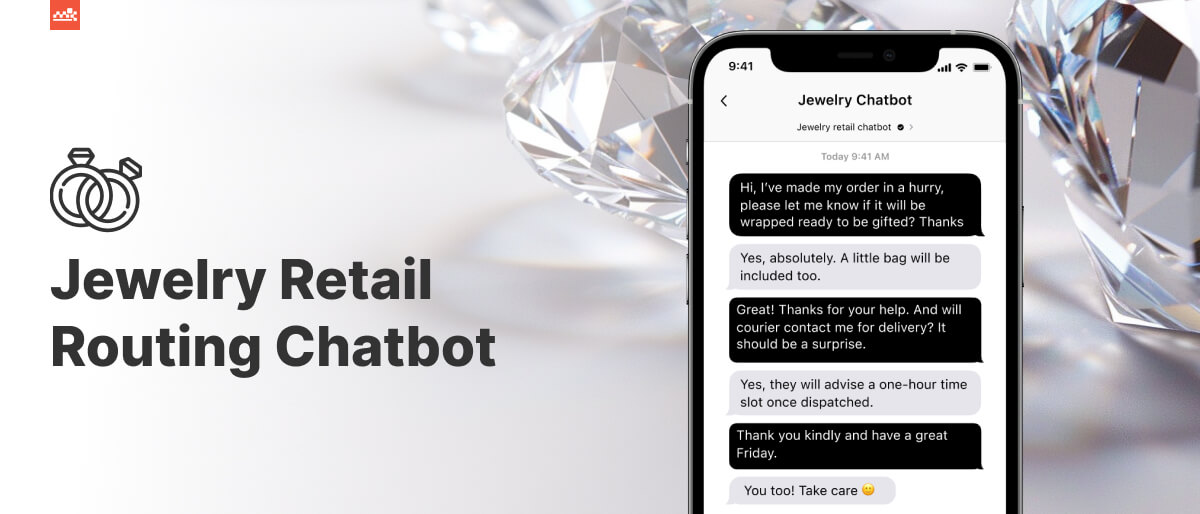
Problem 3: Difficulty engaging website visitors and converting them into leads.
Jake visits a software company’s website, interested in their solutions, but leaves disappointed. The site is cluttered, with no clear calls-to-action or easy contact options. He couldn’t find the required web page, so decided not to submit any forms. The company simply lost the potential lead.
Here customer acquisition chatbots prove invaluable, acting as virtual sales assistants that engage visitors, provide recommendations, and ultimately drive conversions.
Solution 1. Two success stories showcase how Master of Code Global’s custom bots have transformed this process for diverse brands. BloomsyBox, a flower subscription service, sought to increase engagement and drive conversions with a unique approach.
Master of Code Global, in partnership with Infobip, developed the first-ever Generative AI tool that creates personalized greeting cards. This innovative solution engaged the audience with a quiz, offering a free bouquet to winners. An impressive 60% of users interacted with the bot, with 28% winning the prize and 78% of winners claiming their reward.
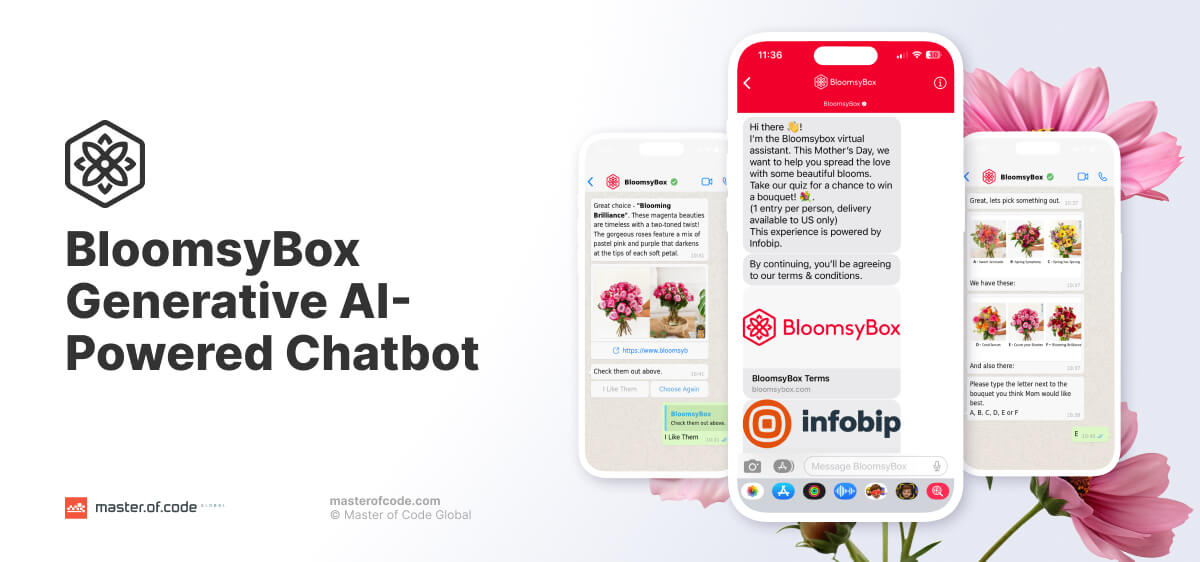
Solution 2. The next success story is from a leading electronics retailer that set a goal to streamline the purchase process and enhance satisfaction. In tight collaboration with Infobip, Master of Code developed an Apple Messages for Business chatbot that acts as a virtual shopping assistant.
This bot, powered by Generative AI, understands queries, provides tailored upselling recommendations, and answers a wide range of product-related questions. The results speak for themselves: an 80% average CSAT score, an 84% engaged session rate, and an average order value of approximately $300.
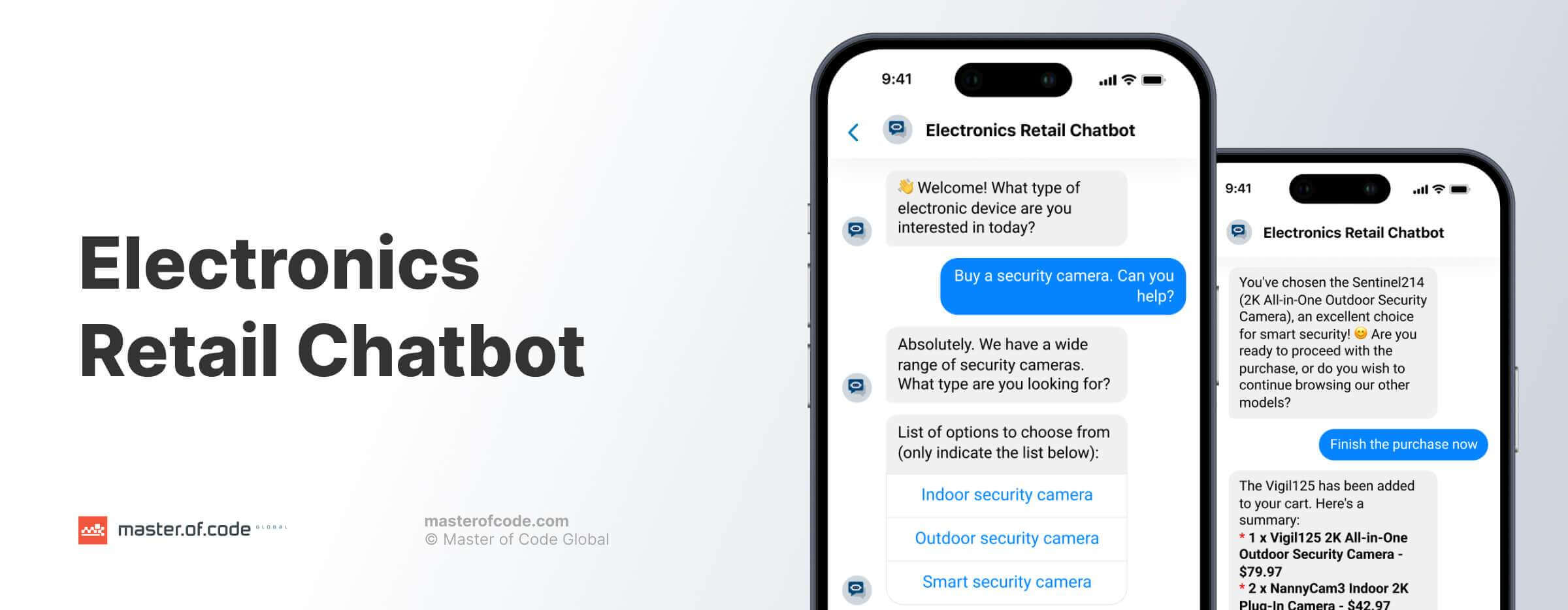
Problem 4: Inconsistent brand messaging across different communication channels
Sarah loves her activewear brand’s eco-friendly message, but mixed signals leave her frustrated. Social media touts sustainability, yet products arrive in plastic, and feedback channels are nearly nonexistent. Meanwhile, Aaron, the brand manager, overlooks customer insights, missing the gap between marketing promises and reality.
If your messaging is disjointed, it can confuse users and weaken your public reputation. Benefits of chatbots for your business include providing consistent communication and a unified brand experience across every channel.
Solution. To strengthen its online presence and provide a cohesive brand image, Burberry partnered with Master of Code Global to develop a chatbot for better customer engagement integrated into Facebook Messenger. This Conversational AI concierge allows fashion enthusiasts to explore behind-the-scenes content, receive product suggestions, and shop runway looks directly within their preferred messaging app.
By infusing the sales funnel with user-centric narratives, Burberry enhanced buyer loyalty, fostering a deeper connection with clients through exclusive content. Furthermore, the tool reinforced Burberry’s brand identity, strengthening its image and differentiating it from competitors by providing a consistent and engaging experience across platforms.

Problem 5: Lack of personalized customer interactions leading to low engagement and retention
Generic interactions can leave people feeling undervalued, highlighting the importance of the rise of digital tools in the client journey. Individuality, on the other hand, fosters a sense of loyalty and connection, which is exactly what sophisticated chatbots can deliver.
Solution. Master of Code Global helped the luxury cosmetics brand La Mer, developing a customer engagement chatbot that acts as a digital skincare concierge. The solution offers unique product recommendations and expert guidance, supporting buyers at every stage of the purchasing funnel. This sophisticated tool boasts over 3,350 meticulously trained utterances and a suite of features designed to enhance client involvement.
Users can take the “Find My Regimen Quiz,” an interactive experience that guides them through a series of questions to identify their skincare needs and provides personalized treatment suggestions. With 5 brand new features and 7 years of dedicated technical support from Master of Code Global, this bot has transformed La Mer’s interaction strategy.
Problem 6: Inability to gather valuable customer insights and feedback
Meet Anna – she is frustrated because her favorite cosmetics brand continuously produces products with low-quality packaging materials. Anna would like to report such an inconvenience, but she has no chance to give her feedback. Mark, the responsible manager at that company, thinks that it’s absolutely enough just to place an email address on their website with that well-known phrase “For any questions and suggestions, please contact…” Is this really enough? No, because Mark has never opened that mailbox to familiarize himself with real consumer feedback.
Solution. While many companies focus on gathering explicit feedback, valuable insights can also be gleaned from other interactions. For one particular brand, the challenge lay in understanding the reasons behind payment refund requests and using this data to improve user experience. To address this, Master of Code enhanced their existing Conversational AI approach, extending its functionality to support streamlined giveback process flows.
Our custom-developed payment refund chatbot now gathers crucial information from users requesting repayments, such as how the order was purchased, the specific issue encountered, and the initial payment method. This data provides invaluable insights into pain points, allowing the brand to identify trends and areas for improvement. The impact of this enhanced chatbot has been significant: agent escalation for refund requests dropped between 42% and 66%, freeing up human agents to focus on more complex issues.
Furthermore, repayment cost savings reached $10.2 million through an optimized and clarified process flow. And due to increased consistency and clarity regarding return policies, the total amount of refunds provided dropped between 13% and 28%.
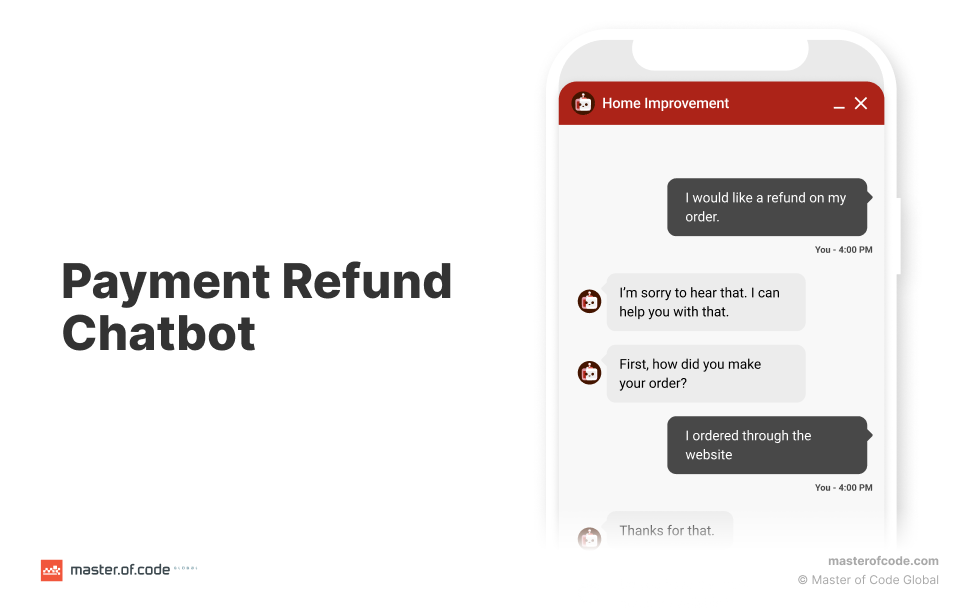
Value Proposition of Conversational AI Solutions
Now, 39% of all chats between businesses and consumers involve AI. It is important to understand that bots are being developed to complement and support humans, not replace them. The benefits of chatbots for enterprises are abundant but will never substitute human ingenuity and passion. Below are a few use cases that highlight the potential for customer experience chatbots to drive consumer satisfaction and sales.
24/7 Availability
Computer programs do not require sleep and do not mind working 24 hours, 7 days a week for below minimum wage. That’s why people believe that these programs are smarter than them. Clients now expect service at any time of day or night; they want their questions answered or their feedback heard. 59% of customers expect a chatbot to respond within 5 seconds (Drift). The bots are being deployed to assist with this change in consumer expectations by providing an outlet for clients to engage and be serviced outside of business hours. People can now have their frequently asked questions answered, information requests delivered, and brands can continue to provide exceptional service through automation, minimizing costs.
Personalized Customer Experience
Conversing with someone who already knows your name, interaction history, and product preferences will almost always deliver a better experience than interacting with someone who repetitively asks for the same information. Bots have the capacity to integrate with client relationship management systems (CRMs) and inventory management systems (IMS) to provide a heightened client journey that is more efficient and engaging. Want to know when the new Google Home Hub becomes available in your city? A quick message to the Best Buy chatbot would respond with the correct information instantly. It even has the ability to ask you if you would like to pre-order the device or browse a similar product instead.
No longer are people willing to look up a phone number, dial the number, and go through pre-set menu options only to be told to stay on the phone while they transfer them to an available agent and then to be put back on hold while the agent looks up that information for them.
Accuracy
Chatbots exhibit remarkable accuracy in delivering information, leveraging advanced algorithms and natural language understanding. They efficiently interpret user queries, providing precise responses tailored to individual needs.
This accuracy enhances customer satisfaction by ensuring quick problem resolution and relevant recommendations. Enterprises benefit immensely from bots, as they foster trust, loyalty, and positive brand perception among consumers. Tailored responses streamline client service operations, reducing the likelihood of errors and misunderstandings.
Moreover, by consistently delivering reliable information, bots contribute to higher conversion rates and increasing sales. Ultimately, these features allow you to improve customer experience with chatbots, driving growth and success for businesses.
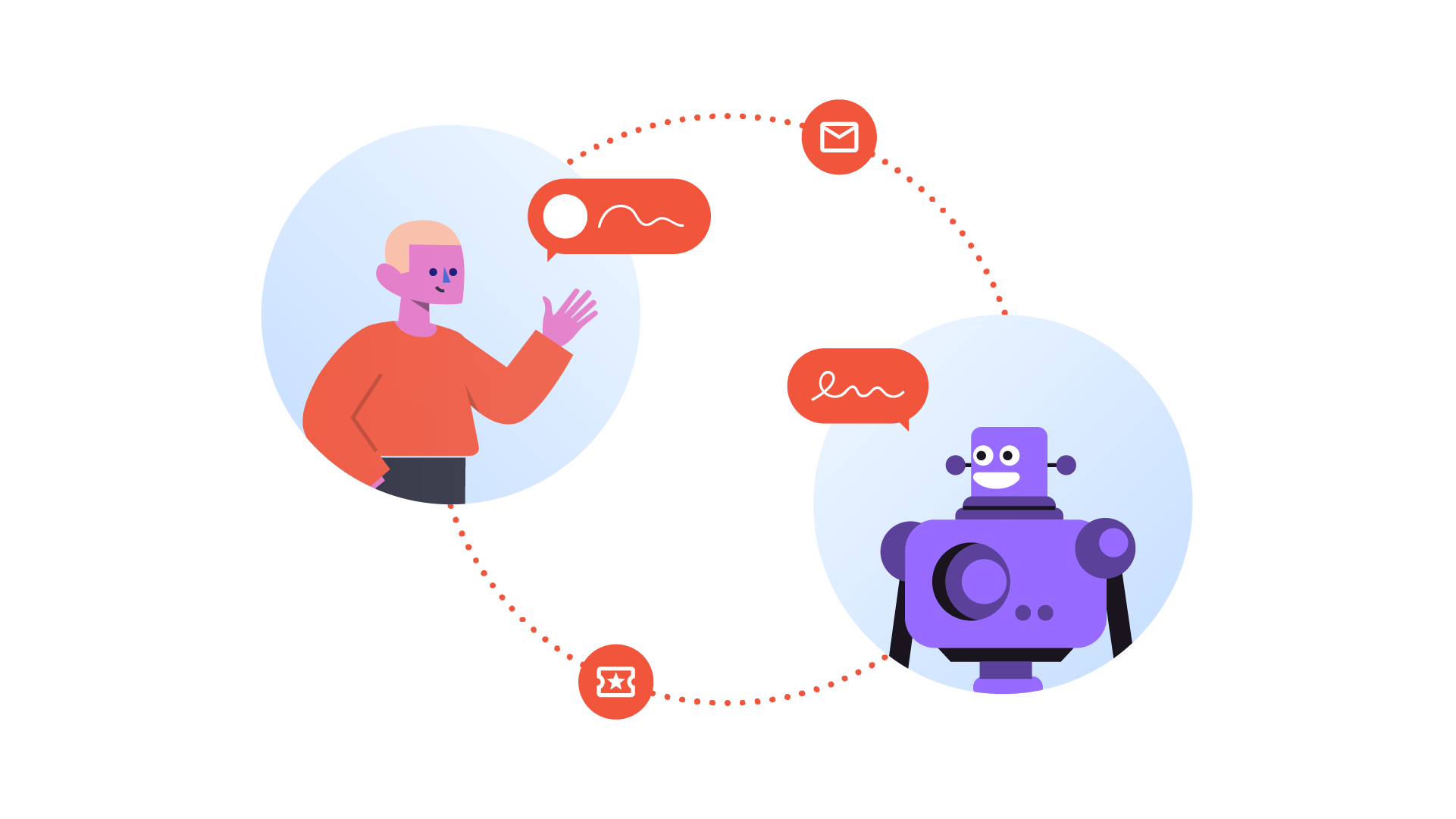
Omnichannel & Multilingual
Companies benefit from increased efficiency and scalability as chatbots handle interactions across multiple channels simultaneously. Furthermore, they smoothly integrate with different communication options and cater to a wide range of language preferences. These bots ensure consistency across channels, enabling smooth transitions between the web, mobile apps, social media, and more.
By being multilingual, they engage with a broader audience, breaking language barriers and expanding market reach. This versatility fosters loyalty and retention. Additionally, such capabilities enable global expansion, tapping into new markets and driving revenue growth.
Self-Service
These conversational solutions offer enterprises a cost-effective solution for managing consumer inquiries and support. By providing instant responses to frequently asked questions, they reduce the burden on human agents, freeing up resources and improving efficiency.
Such bots empower clients to find solutions independently, enhancing contentment and reducing wait times. Businesses worldwide are already reaping the benefits from reduced operational costs and increased productivity as customer service chatbots handle routine inquiries around the clock. Additionally, they contribute to higher client retention rates by offering quick and convenient assistance.
Cost Reduction
In the realm of business operations, chatbots emerge as invaluable assets, primarily by trimming operational expenses. Through the automation of repetitive tasks and the streamlining of processes, they mitigate the necessity for human intervention, consequently lowering labor costs.
By efficiently managing routine flow, they bolster productivity and optimize resource allocation. The average cost of one chatbot interaction calculator is $0.50-0.70. Furthermore, operating 24/7, these conversational solutions furnish uninterrupted support without necessitating additional staffing. Their integration leads to heightened scalability and augmented profitability. Overall, cost reduction bots not only contribute to immediate savings but also facilitate sustained efficiency and growth, cementing their status as indispensable tools for enterprises aiming to fortify their bottom line.
Analytics
Data analytics is another way chatbots improve customer experience. There is something inherently special about raw data, yet capturing the sentiment, range, and needs of a company’s knowledge base is challenging. Often companies capture this type of data through surveys, complaint/feedback systems, or transcribed call recordings. Whereas transactional data is easy to capture, and although it can provide insights, it cannot provide a 360-degree view of the person. Using an AI bot enables the capturing of qualitative data that can be used to improve business processes or product selection.
Every conversation is analyzed, comprehending the pain points of each client and becoming increasingly aware of their true needs. With consumer demands evolving faster than ever, having chatbot analytics can ensure companies are evolving faster, allowing strategies to be developed that follow the latest consumer trends.
How Are These Bots Developed?
Chatbot development consists primarily of a channel interface, a Natural Language Understanding (NLU) or Natural Language Processing (NLP) engine, a bot platform that may allow 3rd party integrations, and a little creativity.
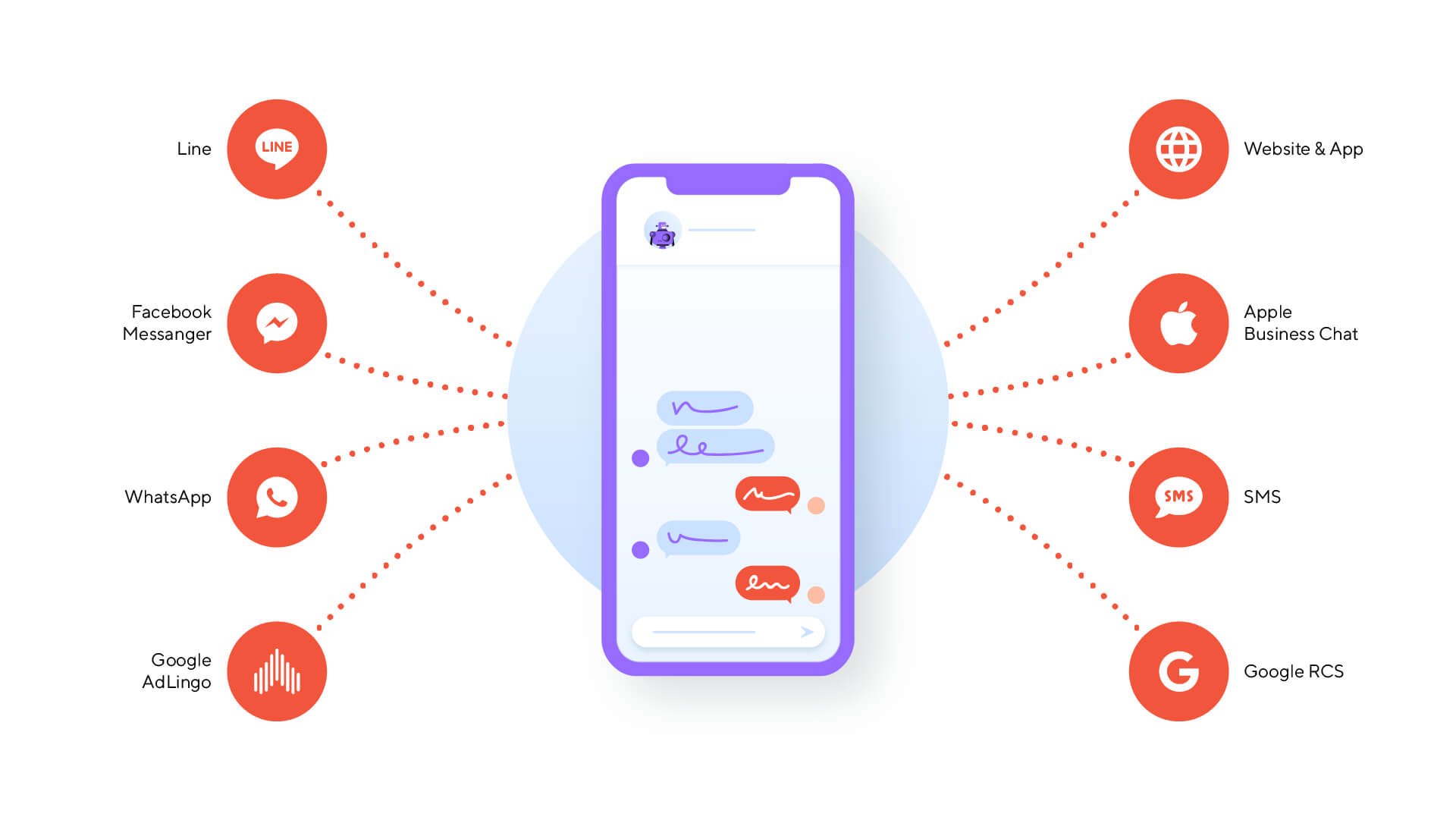
Channel Interfaces
A channel interface is simply the way in which users will interact with the bot, whether it’s through Facebook Messenger, SMS, website widgets, Slack or WhatsApp. Today, these channels are exploding with branded AI bots. With Messenger being used by over 1 billion users, it’s no surprise that there are over 300,000 bots on the platform serving customers every day.
NLU/NLP Engines
Although there are many different implementations of NLU/NLP engines available, we will focus on intent classification machine learning which involves training the bot to understand intents by attributing them with multiple keywords and phrases that users are expected to input into the AI bot. The more the model is trained, the more it understands patterns and learns from them. It’s important to understand how these systems make sense of this data in order to develop a chatbot that correctly answers and guides users.
Intents
An intent is a specific action that a user can invoke or the user’s intention. An example of intent would be if a user types “show me yesterday’s financial news”. The user’s intent is to see a list of financial headlines from yesterday. In development, intents are given names, often a verb or a noun, for this particular case it could be “showNews”. Further, we would define a list of utterances or keywords that would be attached to the relevant intent. For instance, under our “showNews” intent we could have the following utterances:
- “Show me yesterday’s financial news”
- “What’s happening in the financial news”
- “Tell me some news about finance”
Entities
Entities are properties that assist NLU/NLP engines in identifying and extracting meaningful data from natural language inputs, this can consist of a name, location, or date. When the engine parses the user requests and identifies an entity, that value can then be used within the following request. For instance, if a user inputted “Show me yesterday’s financial news”, the word yesterday and financial would be considered entities.
Read also: Instruments to Develop NLP Chatbot
Integrations
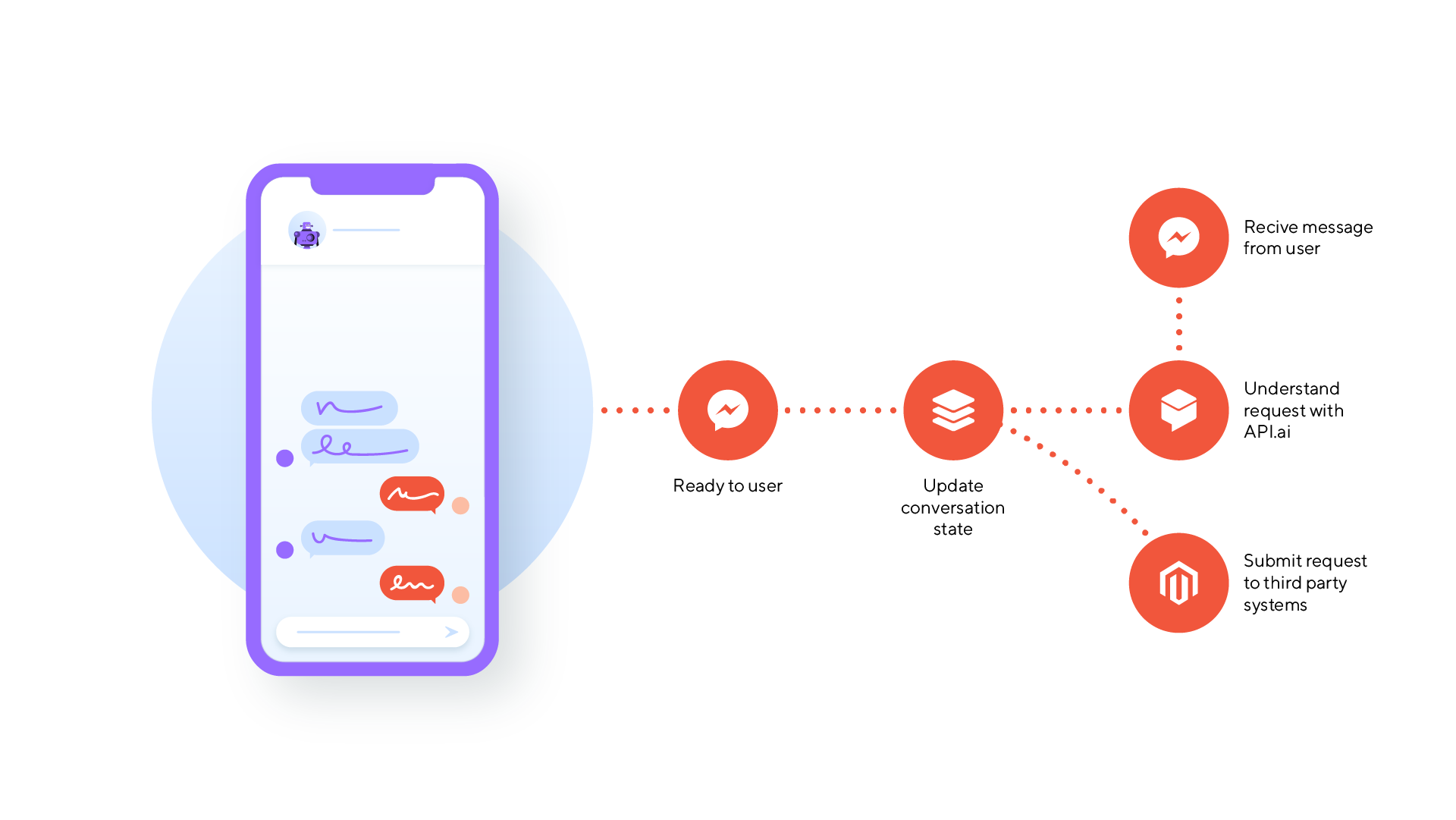
A bot’s capabilities can be extended using third-party APIs which can be integrated into the bot. When the NLU/NLP engine has determined the user’s intent, the next step would be to request that information from some source and send it back to the user to fulfill their request. If we want to create a weather bot that responds to weather and forecast-related requests developers can simply leverage an existing weather API, or maybe we want to schedule an appointment using the Google Calendar API. The possibilities are only limited by imagination.
Not All Chatbots Are Created Equal: The Power of Custom Development
While the market is flooded with off-the-shelf solutions, these basic options often fall short of meeting the unique needs of businesses. They may lack the flexibility to integrate with existing systems, struggle to handle complex queries, or fail to provide a unique approach. In fact, while adoption is growing, only 34% of consumers find AI in customer service actually helpful. This highlights a vital point: to truly unlock the power of chatbots, you need a strategy that’s tailored to your specific requirements.
That’s where custom development comes in. Unlike generic platforms, custom-built bots are designed to align perfectly with your goals and client journeys. They can be seamlessly integrated with your CRM, eCommerce platform, and other critical systems, ensuring a smooth and consistent experience for your consumers.
Moreover, engagement chatbots can be equipped with advanced features such as natural language processing (NLP), sentiment analysis, and machine learning, enabling them to understand user intent, provide customized responses, and even anticipate future needs. This level of sophistication can significantly boost satisfaction and drive retention.
So, why choose Master Of Code Global for your custom development needs? We have a proven track record of delivering high-quality AI and software solutions for businesses of all sizes. Our team of devoted engineers and data scientists will work closely with you to understand your unique challenges and objectives, designing an approach that’s tailored to your specific requirements. We’re not just building digital tools; we’re crafting intelligent conversational encounters that transform the way you interact with your users.
Ready to transform your chatbot engagement and stop churn in its tracks? Contact us today to discuss how our custom solutions can help you build stronger relationships, drive retention, and unlock new levels of growth.
Ready to build your own Conversational AI solution? Let’s chat!


